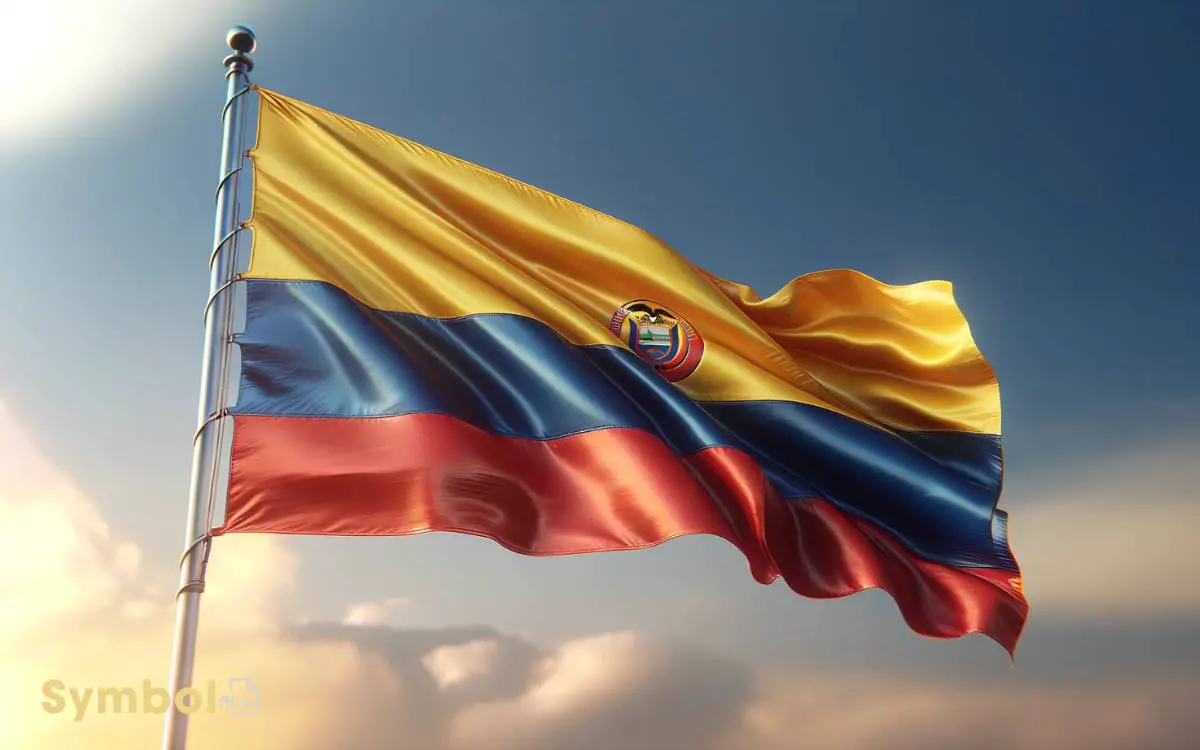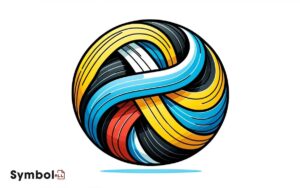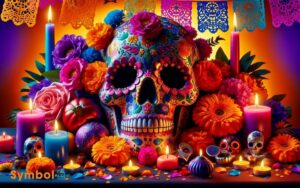What Do the Colors of the Colombian Flag Symbolize
You’re diving into the colors of the Colombian flag, where yellow shines for the nation’s gold wealth, hinting at prosperity and cultural heritage.
This hue echoes Colombia’s historical gold significance. Blue stretches beyond, symbolizing the vast skies and oceans that outline Colombia’s extensive maritime borders, embodying freedom and expansive opportunities.
Red vividly remembers the bloodshed and sacrifices made for independence, standing for the courage and resilience of the Colombian people.
Together, these colors narrate a story of wealth, liberty, and valor. As you explore further, you’ll uncover how these symbols evolve, deepening your connection to Colombia’s vibrant identity and legacy.

Key Takeaway
The Colombian Flag: Overview
The Colombian flag, a vibrant embodiment of the nation’s spirit and history, consists of three horizontal stripes: yellow, blue, and red, each carrying profound symbolic significance.
You’ll find the yellow stripe at the top, occupying half of the flag’s space, symbolizing the country’s wealth and natural resources, particularly gold. Below the yellow stripe lies a green section, representing the nation’s lush vegetation and commitment to growth and prosperity. Together, these colors reflect a unique identity, distinct yet echoing certain universal themes found in flag designs worldwide. For instance, exploring themes like the German flag colors meaning also uncovers narratives of unity and historic significance tied to national values.
The blue stripe represents the Pacific Ocean and the Caribbean Sea, essential for Colombia’s development and its historical connection to the world.
Finally, the red stripe stands for the blood shed by those who fought for Colombia’s independence, highlighting the bravery and sacrifice inherent to the nation’s past.
Together, these colors don’t just decorate a piece of cloth; they narrate Colombia’s resilience, richness, and valor, offering a deeper understanding of its identity.
Historical Origins
Exploring the Colombian flag‘s historical origins, it’s essential to acknowledge how the nation’s pursuit of independence shaped its vibrant emblem.
The flag we recognize today was adopted officially in 1861, but its design traces back to the early 19th century, during the struggle for freedom from Spanish rule.
This period was marked by fervent desires for unity, liberty, and sovereignty, which influenced the flag’s creation.
Leaders such as Francisco de Miranda, a precursor to Latin American independence, played pivotal roles in conceptualizing the flag.
His visions of a liberated continent were symbolically encapsulated in the flag‘s colors, aiming to reflect the shared values and aspirations of the Colombian people.
Therefore, the flag’s inception is deeply intertwined with the nation’s fight for independence, embodying the collective spirit of resistance and hope.
Yellow: A Symbol of Wealth
Amidst the vibrant hues of the Colombian flag, yellow stands out as a symbol of the nation’s wealth and natural resources.
This color isn’t just a stroke of design; it’s a deep reflection of Colombia’s rich deposits of gold and other valuable minerals, which have historically shaped its economy and cultural identity.
The presence of yellow on the flag serves as a constant reminder of the country’s potential prosperity and its rich, diverse environment, which has been both a blessing and a challenge.
| Aspect | Significance |
|---|---|
| Gold Deposits | Represents Colombia’s rich mineral wealth |
| Economic Potential | Symbolizes the promise of prosperity |
| Cultural Identity | Reflects the historical importance of gold |
Understanding this color’s symbolism offers a glimpse into Colombia’s complex heritage and its aspirations for wealth and progress.
Yellow: Natures Bounty
You’ll find that the yellow in the Colombian flag doesn’t just represent the country’s wealth in a vague sense, but specifically points to its rich natural resources and agricultural prosperity.
This color reflects Colombia’s abundant gifts from nature, from its fertile land to the vast variety of minerals beneath its soil, which are pivotal for economic prosperity.
It’s a demonstration of how the nation’s natural bounty has shaped its economic landscape, symbolizing a foundation built on the wealth of the earth itself.
Rich Natural Resources
Why does the yellow stripe on the Colombian flag evoke the country’s rich natural resources? The answer lies in the vivid imagery that this color conjures, symbolizing Colombia’s vast reserves that fuel both its economy and cultural heritage.
Here’s a closer look:
- Gold: Historically, Colombia’s gold has been a cornerstone of its wealth, drawing explorers and contributing immensely to the global market.
- Coal: As one of the top coal producers, Colombia’s coal mines are an essential energy source.
- Emeralds: The country is renowned for producing the highest quality emeralds in the world.
- Oil: Its oil reserves are vital for the national economy, underpinning Colombia’s status in the global oil scene.
Each resource paints a picture of a nation blessed with a wealth that goes beyond the surface, deeply intertwined with its identity and prosperity.
Agricultural Wealth
Beyond its mineral riches, Colombia’s yellow stripe also celebrates its agricultural bounty, showcasing a nation where fertile lands yield an impressive array of crops that sustain and enrich its people.
This vibrant band symbolizes Colombia’s lush valleys and towering mountains, environments perfect for cultivating everything from coffee to bananas, flowers to sugarcane.
You’ll find that this agricultural wealth isn’t just about quantity; it’s deeply intertwined with the quality and diversity of the produce.
The yellow in the flag, consequently, isn’t merely a color; it’s a proof to the country’s ability to harness nature’s bounty.
Through this, Colombia not only feeds itself but also plays an important role in the global food market, exporting its high-quality produce worldwide, hence embedding itself as a key player in international agriculture.
Symbolizing Economic Prosperity
Colombia’s yellow stripe not only celebrates its agricultural wealth but also symbolizes the country’s economic prosperity, driven by its ability to explore nature’s bounty for both domestic nourishment and global trade.
When you investigate further, you’ll find that this color encapsulates the essence of Colombia’s thriving economy:
- Coffee Production: Colombia’s renowned coffee not only shapes its cultural identity but also greatly contributes to its economy.
- Flower Exports: The country is a leading exporter of flowers, showcasing its agricultural diversity and export capabilities.
- Fruit Cultivation: Tropical fruits from Colombia find their way to international markets, demonstrating its agricultural richness.
- Mineral Resources: Beyond agriculture, yellow also hints at the wealth generated from mining precious minerals, further underpinning the nation’s economic landscape.
Understanding this, you grasp how deeply interwoven Colombia’s natural wealth is with its economic prosperity.
Blue: Vast Skies and Oceans
Representing the vast skies and oceans, the blue stripe on the Colombian flag symbolizes the country’s expansive maritime borders and the limitless possibilities that the sky embodies.
This color choice isn’t merely aesthetic; it’s a profound nod to Colombia’s geographical and essential realities.
Surrounded by two major oceans, the Pacific and the Atlantic (via the Caribbean Sea), Colombia’s blue band mirrors these vast bodies of water that have been vital for trade, cultural exchange, and defense.
Similarly, the sky above reflects the nation’s aspirations, dreams, and the boundless opportunities awaiting its people.
It’s a reminder that, just as the ocean and the sky meet at the horizon, Colombia connects various worlds through its unique position, serving as a bridge between the Americas and a gateway to the deep and mysterious tropical latitudes.
Blue: The Quest for Freedom
The blue stripe on the Colombian flag not only mirrors the nation’s vast waters and skies but also embodies its relentless pursuit of freedom. This element serves as a profound reminder of Colombia’s historical struggles and aspirations.
To understand its significance, consider:
- Historical Context: The color blue symbolizes the battle for independence from Spanish rule, highlighting the nation’s yearning for autonomy.
- Cultural Identity: It reflects the collective spirit and resilience of the Colombian people in their quest for self-determination.
- Political Symbolism: Blue represents the ideal of liberty, underlying the democratic values that guide the country.
- Global Message: It sends a message of solidarity to nations worldwide, advocating for freedom and justice.
Through this lens, the blue stripe is a demonstration of Colombia’s enduring pursuit of freedom, encapsulating both its historical struggles and future aspirations.
Red: Bloodshed and Bravery
Moving beyond the serene symbolism of blue, let’s explore the red stripe, which vividly captures the sacrifices and valor inherent in Colombia’s history.
This color isn’t merely a design choice; it’s a profound acknowledgment of the bloodshed endured by countless Colombians in various contexts outside the struggle for independence.
It’s a tribute to the bravery of those who stood firm in the face of adversity, whether in battles that aren’t directly linked to gaining freedom or in efforts to preserve the nation’s integrity and sovereignty.
The red stripe serves as a constant reminder of their courage and the steep price paid for the country’s current standing. It’s a call to remember and honor the resilience and bravery that have sculpted Colombia’s present and future.
Red: The Struggle for Independence
Delving deeper into the significance of red on Colombia’s flag, it’s important to understand how this color embodies the nation’s arduous journey towards independence.
This hue isn’t just a marker of historical events; it’s a vivid representation of the struggle and sacrifice that paved the way for Colombia’s sovereignty.
Here’s why:
- Bloodshed: It symbolizes the blood spilled by the heroes who fought for freedom.
- Sacrifice: Reflects the sacrifices made by countless Colombians in the quest for independence.
- Courage: Stands for the bravery of those who dared to dream of a free nation.
- Persistence: Represents the relentless pursuit of liberty, despite overwhelming odds.
This analytical perspective invites you to appreciate the depth and complexity behind the red in Colombia’s flag, highlighting a story of resilience and determination.
Interpretations Over Time
Over time, interpretations of the red in Colombia’s flag have evolved, reflecting shifts in societal values and historical consciousness. Initially, this vibrant hue symbolized the bloodshed in Colombia’s fight for independence.
However, as the nation matured, so too did the meanings ascribed to this color. Nowadays, it’s seen not only as a reminder of past conflicts but also as a representation of the strength and resilience of the Colombian people.
This evolution signifies a broader understanding of freedom and sovereignty, moving beyond the immediate context of independence to encompass the ongoing struggles and achievements of the nation.
It’s a proof of how symbols can adapt, taking on new significances in line with changing cultural and historical landscapes, deepening the flag’s resonance with the Colombian identity.
Flag Variants and Meanings
You’ve seen how the Colombian flag’s colors have been interpreted over time, but it’s essential to understand the evolution and various applications these symbols have undergone.
From historical shifts that reflect the nation’s journey to the nuanced differences in modern usage, each variant carries a distinct message.
Comparing these symbolic interpretations reveals a deeper insight into Colombia’s identity and values, highlighting the flag’s role in national unity and pride.
Historical Flag Evolution
The evolution of Colombia’s flag has seen various iterations, each embodying distinct periods and ideological shifts within the country’s history.
Here’s a brief analytical overview:
- 1810: The adoption of a flag featuring horizontal bands of yellow, blue, and red, symbolizing Colombia’s aspirations for independence from Spanish rule.
- 1814: Introduction of a flag with a red field and two yellow stars, representing the provinces of Cartagena and Antioquia, showcasing regional pride.
- 1816: A return to the tricolor scheme but with a different configuration, reflecting the changing political landscape.
- 1861: The establishment of the current configuration of the Colombian flag, which solidified national identity and unity.
Each variant not only marks a chapter in Colombia’s quest for sovereignty and self-definition but also reflects the evolving nature of its collective ideals and aspirations.
Modern Usage Differences
In contemporary Colombia, variations of the national flag serve distinct purposes, each imbued with unique interpretations and roles within various societal and governmental contexts.
You’ll find that these variants reflect the nation’s multifaceted identity and its citizens’ values and aspirations.
To understand this better, let’s explore a comparison:
| Variant | Usage | Meaning |
|---|---|---|
| Standard National Flag | National, Official Events | Unity, Freedom, Natural Wealth |
| Civil Ensign | Civilian Use, Maritime | Peace, Global Commerce |
| Government Ensign | Governmental, Military Vessels | Authority, Order |
| Presidential Standard | Presidential Use | Executive Power, Leadership |
| War Flag | Military Use | Bravery, Sovereignty Protection |
Analyzing these differences offers insight into how Colombians perceive their country’s symbols in daily life and state functions, reflecting a deep respect for national heritage and current societal values.
Symbolic Interpretations Compared
Diving deeper into the symbolic interpretations of Colombian flag variants reveals a rich tapestry of meanings that resonate with national identity and socio-political values.
Here’s a closer look at how these interpretations vary:
- Yellow: While universally representing sovereignty and harmony, some variants emphasize its link to the country’s natural wealth, particularly gold.
- Blue: Commonly signifying the two oceans Colombia borders, certain interpretations focus on the sky and waterways as symbols of freedom and transportation.
- Red: Often associated with the blood shed for independence, specific versions highlight its connection to the struggles and resilience of the people.
- Proportions and Arrangement: Different flag variants subtly alter the color ratios or arrangement, emphasizing one element over another, reflecting shifts in national priorities or historical contexts.
These nuances enrich your understanding of Colombia’s flag, offering a glimpse into its evolving identity and values.
Cultural Impact and Pride
Colombian flag colors embody a profound sense of national identity, fostering unity and pride among Colombians.
These colors aren’t just symbols; they’re woven into the fabric of daily life, influencing art, fashion, and even political movements.
The flag serves as a reminder of the country’s struggle for independence and its ongoing journey towards peace and prosperity.
| Aspect | Impact |
|---|---|
| National Events | At celebrations, the flag colors unite everyone, symbolizing collective joy and patriotism. |
| Art and Fashion | Artists and designers often use these colors to evoke a sense of Colombian heritage and creativity. |
| Political Identity | Political movements rally under the flag, drawing strength from its symbolism to advocate for change and unity. |
Understanding this, you grasp not just the colors, but the heart of Colombia.
Conclusion
As you gaze upon the Colombian flag, its vibrant colors whisper tales of a rich heritage.
- The yellow, more than gold, embodies the sun-kissed lands and boundless resources.
- The blue, deeper than the ocean, reflects the vast skies and waters that embrace this nation.
- Finally, the red, vivid as the blood spilled for freedom, honors the heroes’ valiant struggle.
These hues, intertwined, not only symbolize Colombia’s past and present but also inspire a future filled with pride and progress.






